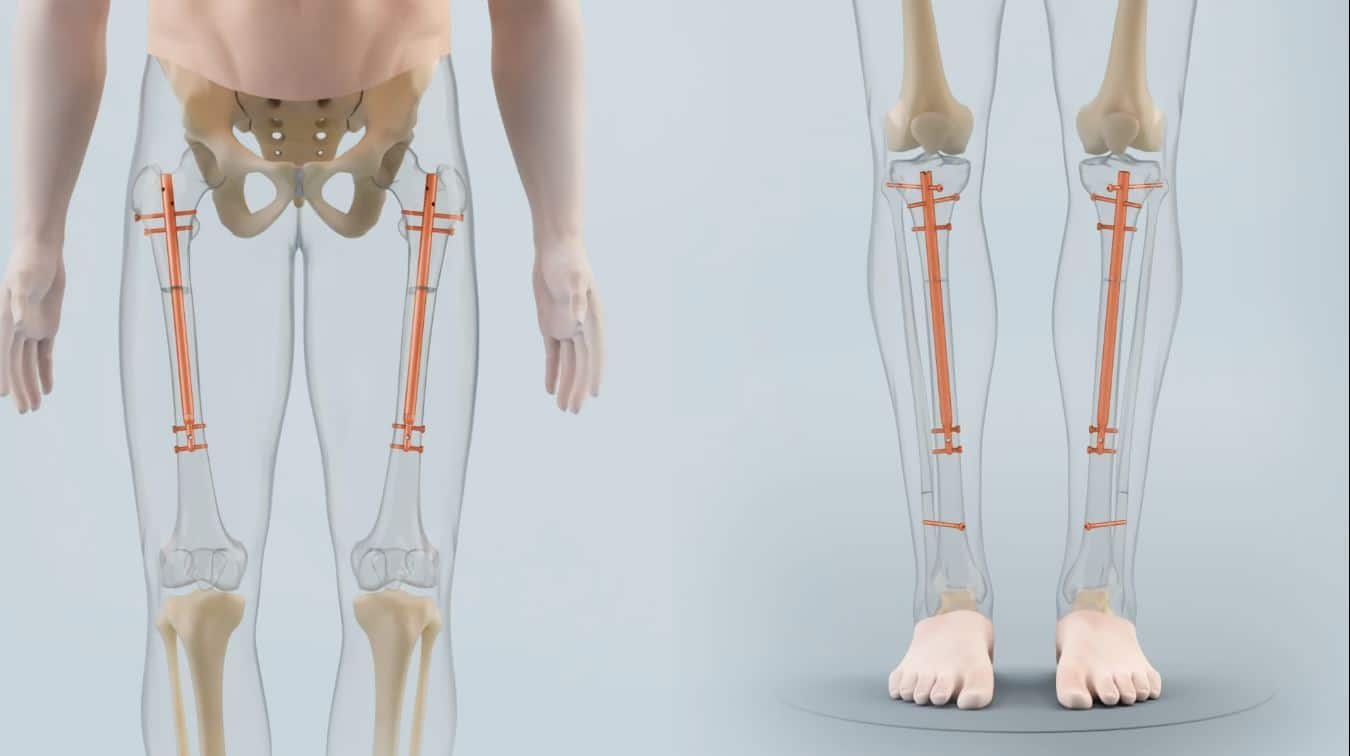
Lengthening surgeryis an orthopedic surgical procedure performed to increase leg length for health problems or aesthetic reasons. The surgery, which can be performed not only on the legs but also on the arms, is performed by cutting the bone that is planned to be lengthened and using an external or internal fixator to widen the space between the split ends. Every day, a small amount of bone is stretched in the widened space, while new bone is produced in the opened area. Lengthening is achieved by the body's own bone, soft tissues, ligaments, blood vessels and nerves that surround and support it, as well as the organism's capacity to form new bone. There is no need to take bone from another part of the body.
What is height lengthening surgery?
Lengthening surgeryis an orthopedic surgery performed to lengthen the bones in the arms and legs, usually for therapeutic purposes and sometimes for aesthetic reasons in individuals with closed growth plates. Lengthening is performed by surgically cutting the bone and separating the cut bone pieces from each other by about 1 millimeter every day over a long period of time. Thus, new bone tissue is formed in the space opened and bone elongation is achieved. The formation of new bone by moving the bones away from each other is called distraction osteogenesis.
If the lengthening is planned to be up to 8 cm, surgery can be performed only on the thigh or tibia. If an extension of more than 10 cm is desired, both bones will need to be lengthened. Lengthening is only performed on the bones. Since the muscles, ligaments, nerves, veins and other soft tissues are attached to the bones and the procedure is done gradually and gradually, they automatically adapt to the lengthening. For this purpose, the process is made easier by applying physiotherapy to the relevant area.
Lengthening surgery can be performed from the age of 3-4. The number of operations to be performed in children is determined according to the calculated amount of shortness. In children with a high amount of shortness, the procedure is planned in two stages before and after the age of 10.
Why is lengthening surgery performed?
Various diseases of genetic origin or childhood can cause a severely short neck. Conditions that cause short stature;
- Some diseases of genetic origin affecting the bones: Achondroplasia, commonly known as dwarfism, is of genetic origin and is the most common cause of short stature. It cannot be treated with medication and the only solution for short stature is lengthening surgery.
- Some childhood diseases that affect growth
- Nutritional disorders
- Hormonal disorders
- Some kidney diseases in childhood
Lengthening surgeryis most commonly performed in cases of dwarfism. However, it can be performed on anyone who is short in stature due to the above-mentioned or other reasons and whose growth cartilages are closed. However, lengthening surgery can also be used to correct shortness and deformity of the arm. It can be successfully performed to lengthen both the arms and legs of individuals with extremely short stature, such as during early puberty periods called dwarfism or puberty precox.
Many patients treated for this problem have leg length inequality as a result of a congenital defect, damage to the growth plate in childhood or bones healing in a deformed position. In these patients with different leg lengths, leg length can be equalized by lengthening the shorter leg. If there is additional deformity in the leg besides shortness, it is treated during lengthening surgery. Bone lengthening surgery can also be performed for aesthetic reasons in very advanced leg curvatures, failed bone fractures, in the treatment of bone inflammation called osteomyelitis, and in individuals who have serious psychological distress due to short stature.
What are the types of lengthening surgery?
Gradual lengthening techniques according to the devices used;
- External fixation (Ilizarov technique)
- Internal fixation (motorized nail)
- The combined technique can be categorized into 3 groups.
For a long time, external fixators, also called the Ilizarov technique, applied externally to the leg have been used in lengthening surgery. However, these devices have now been replaced by internal fixators that are placed inside the body and can be controlled from the outside. Internal fixators are placed inside the body through a small incision and have better cosmetic results. Because external devices leave a scar on the legs equal to the amount of lengthening performed. In the combined technique, both internal and external fixators are used.
How is lengthening surgery performed?
Lengthening surgery is performed under general anesthesia by an experienced orthopedist. In adult patients, the procedure can also be performed using epidural anesthesia, so that patients can be awake during their surgery if they wish.
The procedure starts by cutting the bone to be lengthened in half transversely. This cutting is called osteotomy. After cutting, the leg is stabilized using one or more of several different external and/or internal fixation devices. The treatment consists of two stages.
In the first stage, the cut bone is very slowly separated by the inserted device. This separation process, which stimulates new bone growth at the osteotomy site, is called distraction osteogenesis. For the continuous growth of new bone tissue, the pins in the device are lengthened four times a day, ¼ millimeter in each adjustment, for a total of 1 millimeter. As the space between the ends of the bone opens, the body continues to grow new tissue in the space until the desired length of bone is formed. Additional adjustments can be made to the fixation devices to correct any deformity, such as misalignment of the bone caused by trauma. At this stage, patients learn to walk with the help of crutches.
In the second phase of treatment, the bone hardens and heals. In this phase, called the consolidation phase, the patient is gradually able to put more weight on the affected limb and walk without crutches. If the new bone tissue is thought to have healed completely, the fixation device is removed after an X-ray confirms the healing. The patient can now use their legs normally and return to daily life. When this stage is complete, the new bone tissue is as strong as any other bone in the body.
Operasyon sonrasında ortalama hastanede kalış süresi iki gündür. Prosedür büyük kesikler veya kemik greftleri içermez. Genel olarak, ameliyat öncesinde mevcut ağrı problemi olmayan hastalar, ameliyat veya iyileşme süreci ile ilişkili olarak önemli ağrı yakınması bildirmez. Genel olarak, uzuv uzatma ameliyatları yaklaşık %95 gibi yüksek başarı oranına sahiptir. Ameliyat izi genellikle minimaldir; çünkü çoğu işlemde sadece küçük kesiler yeterlidir.
How long is the recovery time for lengthening surgery?
Lengthening surgery recovery time varies from patient to patient. The second phase of treatment, consolidation, can sometimes take quite a long time, especially in adults. As a general rule, children recover twice as fast as adult patients. For example, if the desired target new bone growth is 4 centimeters, a child will need to use the fixation device for three months, while an adult will take up to 6 months to complete the process.
Physical therapy during recovery plays an important role in keeping the patient's joints flexible and maintaining muscle strength. Patients should eat a nutritious diet and take calcium supplements to speed recovery.
How long does lengthening surgery take?
The surgical procedure for height increase takes approximately 1.5-2 hours. The patient can usually be discharged from the hospital after 2 days if no complications develop.
The time until the healing process is complete and the fixation devices are removed varies according to the technique used and the age of the patient. For example, the time required for a 5 cm lengthening with in-bone devices is approximately 4-6 months in adults.


Contact
We are at your service 24/7
Error: Contact form not found.
Patient Satisfaction
Beautiful thoughts from all of you
If you're looking for car insurance, we will help you to find the You bring emendous value to company. We have generated more leads in the last

Farhan Smith Health Mentor
If you're looking for car insurance, we will help you to find the You bring emendous value to company. We have generated more leads in the last

Elwin Dawson Medical Specialist
If you're looking for car insurance, we will help you to find the You bring emendous value to company. We have generated more leads in the last

Poral Dawson Home Nurse
If you're looking for car insurance, we will help you to find the You bring emendous value to company. We have generated more leads in the last


